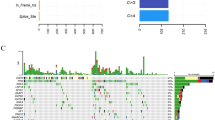Summary
The purpose of the present study was to study the characteristics of epidemic growth factor receptor (EGFR) gene distribution in patients with non-small cell lung cancer (NSCLC), and to detect the mutation rate of EGFR gene by Sanger sequencing and amplification refractory mutation system (ARMS)-PCR. Paraffin-embedded sections of NSCLC tissues from 399 NSCLC patients diagnosed in Renmin Hospital of Wuhan University were collected, 103 of them were detected for exons 18–21 mutation of EGFR by Sanger sequencing method, 296 cases were detected for exons 18–21 mutation by ARMS-PCR method. DNA extraction of both groups was performed with Qiagen QLAamp DNA FFPE Tissue KIT. Comparisons of detection rates between the two methods were conducted by row X list chi-square test. The total mutation rate of EGFR gene detected by Sanger sequencing was 21.4%, exons 18–21 and combined mutation rates were 1.0%, 9.7%, 1.0%, 7.8% and 2.0%, respectively. And the proportions were 4.7%, 45.2%, 4.7%, 36.3% and 9.4% respectively. The total mutation rate detected by ARMS-PCR was 51.4%, exons 18–21 and combined mutation rates were 2.7%, 27%, 1.7%, 18.2% and 1.7%, respectively. The proportions were 5.3%, 52.6%, 3.3%, 35.5% and 3.3% respectively. Further analysis of mutation rate showed that there was significant difference between the two methods in detecting total mutation of EGFR gene (P<0.001). There were significant differences in mutation detection rates of exons 19 and 21 (P<0.001, P<0.05), but there were no significant differences in other exons. And there was no significant difference in mutation detection rates between the two methods. The mutation rate of EGFR gene in NSCLC patients was 50%. And exon 19 deletion was the most common mutation type, followed by exon 21 mutation. Compared with Sanger sequencing method, ARMS method is more sensitive with significant advantages in detecting exon 19 deletions and exon 21 mutations, which can be widely used in clinical detection of EGFR gene mutations. The results of this study will further guide patients with advanced NSCLC to select TKI targeted drugs, and provide clinical diagnostic basis for targeted therapy of NSCLC patients.
Similar content being viewed by others
References
Roointan A, Ahmad Mir T, Ibrahim Wani S, et al. Early detection of lung cancer biomarkers through biosensor technology: A review. J Pharm Biomed Anal, 2019,164:93–103
Xin Y, Huang X, Li Z, et al. Versatile Pt NCs-based chemotherapeutic agents significantly induce the apoptosis of cisplatin-resistant non-small cell lung cancer. Biochem Biophys Res Commun, 2019,512(2):218–223
Milik SN, Lasheen DS, Serya RAT, et al. How to train your inhibitor: Design strategies to overcome resistance to Epidermal Growth Factor Receptor inhibitors. Eur J Med Chem, 2017,142:131–151
Ishige T, Itoga S, Matsushita K, et al. Locked nucleic acid probe enhances Sanger sequencing sensitivity and improves diagnostic accuracy of high-resolution melting-based KRAS mutational analysis. Clin Chim Acta, 2016,457:75–80
Zhu Y, Guo Z, Liu Y, et al. A novel ARMS-based assay for the quantification of EGFR mutations in patients with lung adenocarcinoma. Oncol Lett, 2018,15(3):2905–2912
Dajac J, Kamdar J, Moats A, et al. To Screen or not to Screen: Low Dose Computed Tomography in Comparison to Chest Radiography or Usual Care in Reducing Morbidity and Mortality from Lung Cancer. Cureus, 2016,8(4):e589
Ke L, Xu M, Jiang X, et al. Epidermal Growth Factor Receptor (EGFR) Mutations and Anaplastic Lymphoma Kinase/Oncogene or C-Ros Oncogene 1 (ALK/ROS1) Fusions Inflict Non-Small Cell Lung Cancer (NSCLC) Female Patients Older Than 60 Years of Age. Med Sci Monit, 2018,24:9364–9369
Nakata A, Yoshida R, Yamaguchi R, et al. Elevated beta-catenin pathway as a novel target for patients with resistance to EGF receptor targeting drugs. Sci Rep, 2015,5:13076
Roskoski R, Jr. ErbB/HER protein-tyrosine kinases: Structures and small molecule inhibitors. Pharmacol Res, 2014,87:42–59
Gazzeri S. Nuclear EGFR: a new mode of oncogenic signalling in cancer. Biol Aujourdhui (French), 2018,212(1–2):27–33
Qiu X, Yuan H, Sima B. Relationship between EGFR mutation and computed tomography characteristics of the lung in patients with lung adenocarcinoma. Thorac Cancer, 2019,10(2):170–174
Wang ZF, Ren SX, Li W, et al. Frequency of the acquired resistant mutation T790 M in non-small cell lung cancer patients with active exon 19Del and exon 21 L858R: a systematic review and meta-analysis. BMC Cancer, 2018,18(1):148
Cai YR, Dong YJ, Wu HB, et al. Micropapillary: A component more likely to harbour heterogeneous EGFR mutations in lung adenocarcinomas. Sci Rep, 2016,6:23755
Xue C, Hu Z, Jiang W, et al. National survey of the medical treatment status for non-small cell lung cancer (NSCLC) in China. Lung Cancer, 2012,77(2):371–375
Yoshizawa A, Sumiyoshi S, Sonobe M, et al. Validation of the IASLC/ATS/ERS lung adenocarcinoma classification for prognosis and association with EGFR and KRAS gene mutations: analysis of 440 Japanese patients. J Thorac Oncol, 2013,8(1):52–61
Choi YL, Sun JM, Cho J, et al. EGFR mutation testing in patients with advanced non-small cell lung cancer: a comprehensive evaluation of real-world practice in an East Asian tertiary hospital. PLoS One, 2013,8(2):e56011
Zhang YL, Yuan JQ, Wang KF, et al. The prevalence of EGFR mutation in patients with non-small cell lung cancer: a systematic review and meta-analysis. Oncotarget, 2016,7(48):78 985–78 993
McCourt CM, McArt DG, Mills K, et al. Validation of next generation sequencing technologies in comparison to current diagnostic gold standards for BRAF, EGFR and KRAS mutational analysis. PLoS One, 2013,8(7):e69604
Zhang S, Dang Y, Zhang Q, et al. Tetra-primer amplification refractory mutation system PCR (T-ARMS-PCR) rapidly identified a critical missense mutation (P236T) of bovine ACADVL gene affecting growth traits. Gene, 2015,559(2):184–188
Author information
Authors and Affiliations
Corresponding author
Additional information
Conflict of Interest Statement
The authors declare no competing financial interests. The manuscript has been seen and approved by all authors.
This study was supported by grants from the National Natural Science Foundation of China (No. 81100959) and Natural Science Fund of Hubei Province (No. 2015CFB185).
Rights and permissions
About this article
Cite this article
Zheng, Hy., Wang, Hb., Shen, Fj. et al. EGFR Gene Mutation and Methodological Evaluation in 399 Patients with Non-small Cell Lung Cancer. CURR MED SCI 40, 78–84 (2020). https://doi.org/10.1007/s11596-020-2149-5
Received:
Revised:
Published:
Issue Date:
DOI: https://doi.org/10.1007/s11596-020-2149-5




